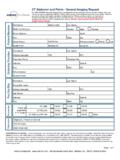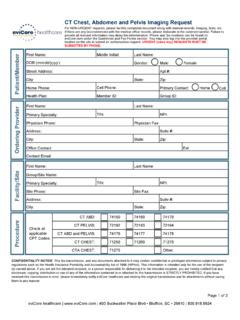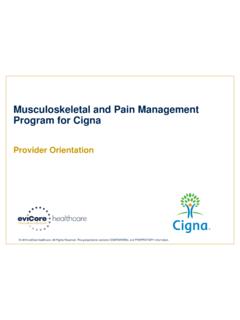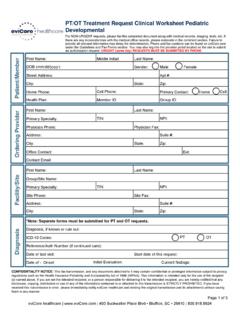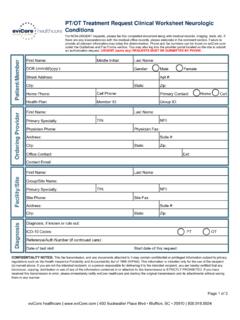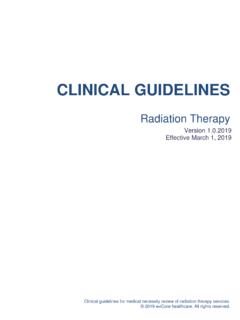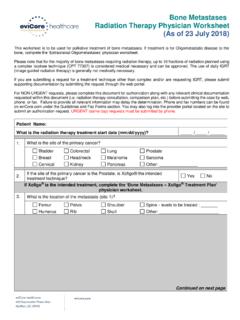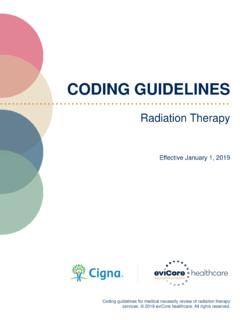Transcription of Cigna Medical Coverage Policies – Radiology Cardiac Imaging
1 Cigna Medical Coverage Policies Radiology Cardiac Imaging Effective March 15, 2019. _____. Instructions for use The following Coverage policy applies to health benefit plans administered by Cigna . Coverage Policies are intended to provide guidance in interpreting certain standard Cigna benefit plans and are used by Medical directors and other health care professionals in making Medical necessity and other Coverage determinations. Please note the terms of a customer's particular benefit plan document may differ significantly from the standard benefit plans upon which these Coverage Policies are based. For example, a customer's benefit plan document may contain a specific exclusion related to a topic addressed in a Coverage policy. In the event of a conflict, a customer's benefit plan document always supersedes the information in the Coverage policy.
2 In the absence of federal or state Coverage mandates, benefits are ultimately determined by the terms of the applicable benefit plan document. Coverage determinations in each specific instance require consideration of: 1. The terms of the applicable benefit plan document in effect on the date of service 2. Any applicable laws and regulations 3. Any relevant collateral source materials including Coverage Policies 4. The specific facts of the particular situation Coverage Policies relate exclusively to the administration of health benefit plans. Coverage Policies are not recommendations for treatment and should never be used as treatment guidelines. This evidence-based Medical Coverage policy has been developed by eviCore, Inc. Some information in this Coverage policy may not apply to all benefit plans administered by Cigna .
3 These guidelines include procedures eviCore does not review for Cigna . Please refer to the Cigna CPT. code list for the current list of high-tech Imaging procedures that eviCore reviews for Cigna . CPT (Current Procedural Terminology) is a registered trademark of the American Medical Association (AMA). CPT five digit codes, nomenclature and other data are copyright 2017 American Medical Association. All Rights Reserved. No fee schedules, basic units, relative values or related listings are included in the CPT book. AMA does not directly or indirectly practice medicine or dispense Medical services. AMA assumes no liability for the data contained herein or not contained herein. Imaging Guidelines Cardiac Imaging Guidelines Abbreviations For Cardiac Imaging Guidelines 3. Glossary 4.
4 CD-1: General Guidelines 5. CD-2: Echocardiography (ECHO) 15. CD-3: Nuclear Cardiac Imaging 27. CD-4: Cardiac CT, Coronary CTA, and CT for Coronary Calcium (CAC) 33. CD-5: Cardiac MRI 41. CD-6: Cardiac PET 46. CD-7: Diagnostic Heart Catheterization 49. CD-8: Pulmonary Artery and Vein Imaging 56. CD-9: Congestive Heart Failure 59. CD-10: Cardiac Trauma 62. CD-11: Section left intentionally blank 64. _____. 2019 eviCore healthcare. All Rights Reserved. Page 2 of 66. 400 Buckwalter Place Boulevard, Bluffton, SC 29910 (800) 918-8924 Imaging Guidelines Abbreviations for Cardiac Imaging Guidelines ACC American College of Cardiology ACS acute coronary syndrome AHA American Heart Association ASCOT Anglo-Scandinavian Cardiac Outcomes Trial ASD atrial septal defect BMI body mass index CABG coronary artery bypass grafting CAD coronary artery disease CHF congestive heart failure COPD chronic obstructive pulmonary disease CT computed tomography CCTA coronary computed tomography angiography CTA computed tomography angiography EBCT electron beam computed tomography ECP external counterpulsation (also known as EECP).
5 ECG electrocardiogram ECP external counterpulsation ETT exercise treadmill stress test FDG Fluorodeoxyglucose, a radiopharmaceutical used to measure myocardial metabolism HCM hypertrophic cardiomyopathy IV intravenous LAD left anterior descending coronary artery LDL-C low density lipoprotein cholesterol LHC left heart catheterization LV left ventricle LVEF left ventricular ejection fraction MI myocardial infarction MPI myocardial perfusion Imaging (SPECT study, nuclear Cardiac study). MRA magnetic resonance angiography MRI magnetic resonance Imaging millisievert (a unit of radiation exposure) equal to an effective dose of a joule of mSv energy per kilogram of recipient mass MUGA multi gated acquisition scan of the Cardiac blood pool percutaneous coronary intervention (includes percutaneous coronary PCI.)
6 Angioplasty (PTCA) and coronary artery stenting). PET positron emission tomography PTCA percutaneous coronary angioplasty RHC right heart catheterization SPECT single photon emission computed tomography TEE transesophageal echocardiogram TIA Transient Ischemic Attack VSD ventricular septal defect _____. 2019 eviCore healthcare. All Rights Reserved. Page 3 of 66. 400 Buckwalter Place Boulevard, Bluffton, SC 29910 (800) 918-8924 Imaging Guidelines Glossary Agatston Score: a nationally recognized calcium score for the coronary arteries based on Hounsfield units and size (area) of the coronary calcium Angina: principally chest discomfort, exertional (or with emotional stress) and relieved by rest or nitroglycerine Anginal variants or equivalents: a manifestation of myocardial ischemia which is perceived by individuals to be (otherwise unexplained) dyspnea, unusual fatigue, more often seen in women and may be unassociated with chest pain ARVD/ARVC Arrhythmogenic Right Ventricular Dysplasia/Cardiomyopathy: a potentially lethal inherited disease with syncope and rhythm disturbances, including sudden death, as presenting manifestations BNP.
7 B-type natriuretic peptide, blood test used to diagnose and track heart failure (n-T-pro-BNP is a variant of this test). Brugada Syndrome: an electrocardiographic pattern that is unique and might be a marker for significant life threatening dysrhythmias Double Product (Rate Pressure Product): an index of Cardiac oxygen consumption, is the systolic blood pressure times heart rate, generally calculated at peak exercise;. over 25000 means an adequate stress load was performed Fabry's Disease: an infiltrative cardiomyopathy, can cause heart failure and arrhythmias Hibernating myocardium: viable but poorly functioning or non-functioning myocardium which likely could benefit from intervention to improve myocardial blood supply Optimized Medical Therapy should include (where tolerated): antiplatelet agents, calcium channel antagonists, partial fatty acid oxidase inhibitors ( ranolazine), statins, short-acting nitrates as needed, long-acting nitrates up to 6 months after an acute coronary syndrome episode, beta blocker drugs (optional), angiotensin- converting enzyme (ACE) inhibitors/angiotensin receptor blocking (ARB) agents (optional).
8 Platypnea: shortness of breath when upright or seated (the opposite of orthopnea). and can indicate Cardiac malformations, shunt or tumor Silent ischemia: Cardiac ischemia discovered by testing only and not presenting as a syndrome or symptoms Syncope: loss of consciousness; near-syncope is not syncope Takotsubo cardiomyopathy: apical dyskinesis oftentimes associated with extreme stress and usually thought to be reversible Troponin: a marker for ischemic injury, primarily Cardiac _____. 2019 eviCore healthcare. All Rights Reserved. Page 4 of 66. 400 Buckwalter Place Boulevard, Bluffton, SC 29910 (800) 918-8924 Imaging Guidelines CD-1: General Guidelines : General Issues Cardiac 6. : Stress Testing without Imaging Procedures 8. : Stress Testing with Imaging -Procedures 8. : Stress Testing with Imaging Indications 8.
9 : Stress Testing with Imaging - Preoperative 10. : Transplant Individuals 11. : Non- Imaging Heart Function and Cardiac Shunt Imaging 12. : Section left intentionally blank 12. _____. 2019 eviCore healthcare. All Rights Reserved. Page 5 of 66. 400 Buckwalter Place Boulevard, Bluffton, SC 29910 (800) 918-8924 Imaging Guidelines Practice Estimate of Effective Radiation Dose chart for Selected Imaging Studies Estimate of Effective Imaging STUDY. Radiation Dose Sestamibi myocardial perfusion study (MPI) 9-12 mSv PET myocardial perfusion study: 3 mSV. Rubidium-82. 2 mSV. NH3. Thallium myocardial perfusion study (MPI) 22-31 mSv Diagnostic conventional coronary angiogram (cath) 5-10 mSv Computed tomography coronary angiography (CTCA) 5-15 mSv (with prospective gating) Less than 5 mSv CT of Abdomen and pelvis 8-14 mSv Chest x-ray < mSv : General Issues Cardiac Cardiac Imaging is not indicated if the results will not affect individual management decisions.
10 If a decision to perform Cardiac catheterization or other angiography has already been made, there is often no need for Imaging stress testing. A current clinical evaluation (within 60 days) is required prior to considering advanced Imaging , which includes: Relevant history and physical examination and appropriate laboratory studies and non-advanced Imaging modalities, such as recent ECG (within 60 days), chest x-ray or ECHO/ultrasound, after symptoms started or worsened. Effort should be made to obtain copies of reported abnormal ECG studies in order to determine whether the ECG is uninterpretable for ischemia on ETT. Most recent previous stress testing and its findings should be obtained. Other meaningful contact (telephone call, electronic mail or messaging) by an established individual can substitute for a face-to-face clinical evaluation.
